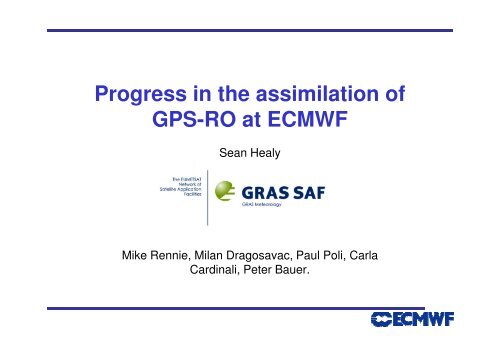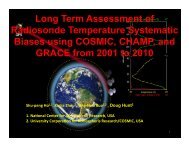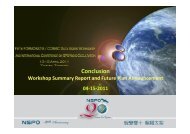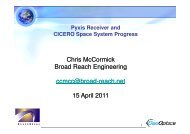Progress in the assimilation of GPS-RO at ECMWF
Progress in the assimilation of GPS-RO at ECMWF
Progress in the assimilation of GPS-RO at ECMWF
You also want an ePaper? Increase the reach of your titles
YUMPU automatically turns print PDFs into web optimized ePapers that Google loves.
<strong>Progress</strong> <strong>in</strong> <strong>the</strong> <strong>assimil<strong>at</strong>ion</strong> <strong>of</strong><strong>GPS</strong>-<strong>RO</strong> <strong>at</strong> <strong>ECMWF</strong>Sean HealyMike Rennie, Milan Dragosavac, Paul Poli, CarlaCard<strong>in</strong>ali, Peter Bauer.
Impact <strong>of</strong> <strong>GPS</strong>-<strong>RO</strong>• The impact <strong>of</strong> <strong>GPS</strong>-<strong>RO</strong> NWP and clim<strong>at</strong>e reanalysis applic<strong>at</strong>ionshas been summarised <strong>in</strong> <strong>the</strong> keynote address by <strong>ECMWF</strong>’s DG.• Despite <strong>the</strong> rel<strong>at</strong>ively low observ<strong>at</strong>ion number <strong>GPS</strong>-<strong>RO</strong> has asignificant impact.– Assimil<strong>at</strong>ion without bias correction– Superior vertical resolution• <strong>GPS</strong>-<strong>RO</strong> has reduced str<strong>at</strong>ospheric temper<strong>at</strong>ure biases, anchoredradiance bias correction and is likely to be useful <strong>in</strong> <strong>the</strong> development<strong>of</strong> “weak constra<strong>in</strong>t” 4D-Var.• Question: How do we improve <strong>the</strong> impact <strong>of</strong> <strong>GPS</strong>-<strong>RO</strong>? NWPusers and d<strong>at</strong>a providers must work toge<strong>the</strong>r on this.
Improv<strong>in</strong>g <strong>the</strong> impact <strong>of</strong> <strong>GPS</strong>-<strong>RO</strong>• Improvements <strong>in</strong> how we assimil<strong>at</strong>e <strong>the</strong> <strong>GPS</strong>-<strong>RO</strong> measurements willpartly depend on forward model development.– Summarise recent changes <strong>at</strong> <strong>ECMWF</strong>.– Outl<strong>in</strong>e our plans for <strong>the</strong> 2D oper<strong>at</strong>or.• Be aware <strong>of</strong> <strong>the</strong> limit<strong>at</strong>ions <strong>of</strong> <strong>the</strong> measurement technique.– The <strong>GPS</strong>-<strong>RO</strong> null-space.
Oper<strong>at</strong>ional <strong>assimil<strong>at</strong>ion</strong> <strong>at</strong> <strong>ECMWF</strong>• We assimil<strong>at</strong>e bend<strong>in</strong>g angles with a 1D oper<strong>at</strong>or. This ignores <strong>the</strong> 2Dn<strong>at</strong>ure <strong>of</strong> <strong>the</strong> measurement and <strong>in</strong>tegr<strong>at</strong>esα( a)= −2a∞∫ad ln ndx2 2x−adx• The forward model now <strong>in</strong>cludes non-ideal gas effects when evalu<strong>at</strong><strong>in</strong>g<strong>the</strong> model level heights (Aparicio et al, 2009) and when evalu<strong>at</strong><strong>in</strong>g <strong>the</strong>refractivity on model levels based on Rueger and Thayer (Healy 2011).• I’d also recommend Aparicio and Laroche, PIP, JGR, 2011.• We also <strong>in</strong>clude a maximum refractivity gradient <strong>in</strong> <strong>the</strong> bend<strong>in</strong>g anglecalcul<strong>at</strong>ion.
Maximum refractivity gradient <strong>in</strong> <strong>the</strong> observ<strong>at</strong>ionoper<strong>at</strong>or• Problem: assumption <strong>of</strong> l<strong>in</strong>earity <strong>in</strong> <strong>in</strong>cremental 4D-Var when closeto “duct<strong>in</strong>g” (strong refractivity gradients) conditions.i+1iIn orig<strong>in</strong>al version <strong>of</strong> <strong>the</strong> oper<strong>at</strong>ordid not calcul<strong>at</strong>e <strong>the</strong> bend<strong>in</strong>g below (i+1) ifn r≥ni i i+1 i+1However, problems arose if <strong>the</strong> separ<strong>at</strong>ionwas only a few metres. Partial deriv<strong>at</strong>ivescan get very large – eg,∂α∂qr
Previously <strong>in</strong> oper<strong>at</strong>ionsOnly calcul<strong>at</strong>e bend<strong>in</strong>g angles below (i+1) if( ni+ 1 ir − n r ) > 101 i+iYes, it’s a bit ad-hoc. Seemed to work. But <strong>the</strong> MetOffice had 4D-Var convergence problems, so we put <strong>in</strong> amaximum gradient:⎛ dN ⎞max⎜− ⎟ = 0.157⎝ dx ⎠⎛ dN ⎞max⎜− ⎟ = 0.157 / 2⎝ dr ⎠
Test<strong>in</strong>g maximum N gradient <strong>at</strong> <strong>ECMWF</strong>• Some reduction <strong>in</strong> <strong>the</strong> (o-b)/sigma_o bend<strong>in</strong>g angle biases <strong>in</strong> <strong>the</strong>tropical lower troposphere. EG, COSMIC-4 noise normalised st<strong>at</strong>s.• Wh<strong>at</strong> is <strong>the</strong> MAXIMUM GRADIENT <strong>GPS</strong>-<strong>RO</strong> can measure?Black = dN/dx max <strong>in</strong>cluded
Tangent po<strong>in</strong>t drift• Work stimul<strong>at</strong>ed by paper by Foelsche et al (2010) and discussionswith Mike Rennie/John Eyre. Milan Dragosavac made <strong>the</strong> code changes.• The <strong>GPS</strong>-<strong>RO</strong> observ<strong>at</strong>ion oper<strong>at</strong>or <strong>in</strong> <strong>the</strong> next oper<strong>at</strong>ional cycle will <strong>in</strong>cludetangent po<strong>in</strong>t drift. (MF, NCEP already <strong>in</strong>clude this).• I did not th<strong>in</strong>k this was an important source <strong>of</strong> forward model error <strong>in</strong><strong>the</strong> str<strong>at</strong>osphere (where we were already do<strong>in</strong>g a very good job!) butth<strong>at</strong> was <strong>in</strong>correct.• Bend<strong>in</strong>g angle departure st<strong>at</strong>istics are clearly improved and improved w<strong>in</strong>dscores.
(o-b) and (o-a) bend<strong>in</strong>g angle departure st<strong>at</strong>istics(noise normalized)Black = tpd experimentRed = fixed loc<strong>at</strong>ion(Dotted l<strong>in</strong>e = analysisdepartures)COSMIC-4GRAS
Z500Reduction <strong>in</strong> 24 hrRMS errors asa result <strong>of</strong> TPDZ100
Str<strong>at</strong>ospheric w<strong>in</strong>d scores aga<strong>in</strong>stobserv<strong>at</strong>ions: fractional reduction <strong>in</strong> RMS errorPositive impact
An agreed def<strong>in</strong>ition <strong>of</strong> “occult<strong>at</strong>ion po<strong>in</strong>t” (“meantangent po<strong>in</strong>t”) <strong>in</strong> BUFR files would be helpfulGRASTSX
2D bend<strong>in</strong>g angle oper<strong>at</strong>or plans• The <strong>ECMWF</strong> 2D bend<strong>in</strong>g angle oper<strong>at</strong>or is freely available as part <strong>of</strong><strong>the</strong> GRAS SAF <strong>RO</strong>PP-4.0 (http://www.grassaf.org/s<strong>of</strong>tware.php).• We’ll <strong>in</strong>troduce tangent po<strong>in</strong>t drift <strong>in</strong> <strong>the</strong> 2D oper<strong>at</strong>or (but we’ll see ifwe can use b<strong>at</strong>ches <strong>of</strong> bend<strong>in</strong>g angles <strong>at</strong> a given l<strong>at</strong>/lon).• We’ll <strong>in</strong>troduce a correction to account for <strong>the</strong> impact parametervari<strong>at</strong>ion along <strong>the</strong> ray p<strong>at</strong>h: da/ds=(∂n/∂θ)r. (I still do not understandwhy this is not a problem <strong>in</strong> <strong>the</strong> non-local phase/refractivityoper<strong>at</strong>ors ).• Investig<strong>at</strong>e 2D/1D differences as a function <strong>of</strong> NWP resolution.• Investig<strong>at</strong>e <strong>the</strong> w<strong>at</strong>er vapour <strong>in</strong>form<strong>at</strong>ion derived from 2D oper<strong>at</strong>or.
Compar<strong>in</strong>g impact <strong>of</strong> <strong>GPS</strong><strong>RO</strong> and IASI• Control: essentially <strong>the</strong> full observ<strong>in</strong>g system.• Basel<strong>in</strong>e experiment: Control m<strong>in</strong>us all level 1b sounder radiances,all <strong>GPS</strong><strong>RO</strong> measurements and all aircraft temper<strong>at</strong>uremeasurements.• Investig<strong>at</strong>ed:– Basel<strong>in</strong>e + <strong>GPS</strong><strong>RO</strong>– Basel<strong>in</strong>e + IASI– Basel<strong>in</strong>e + IASI + <strong>GPS</strong><strong>RO</strong>.
Comparison with IASI, rel<strong>at</strong>ive to a poor basel<strong>in</strong>esystem.KEY QUESTION: How many <strong>GPS</strong><strong>RO</strong> receivers do we need?Will COSMIC-2 surpass <strong>the</strong> impact <strong>of</strong> IASI?
(IASI + <strong>RO</strong>) vs <strong>RO</strong> fit to radiosonde TStandard devi<strong>at</strong>ion (K)Bias (K)(IASI + <strong>RO</strong>) is produc<strong>in</strong>g much better str<strong>at</strong>ospheric biasesthan just <strong>GPS</strong><strong>RO</strong> generally, but most obvious <strong>at</strong> <strong>the</strong>S.Pole. Why is <strong>GPS</strong><strong>RO</strong> not do<strong>in</strong>g a better job? The<strong>GPS</strong><strong>RO</strong> measurement has a “null space”.
Null space – how does <strong>the</strong> temper<strong>at</strong>ure difference <strong>at</strong><strong>the</strong> S.Pole propag<strong>at</strong>e through <strong>the</strong> observ<strong>at</strong>ion oper<strong>at</strong>or∆xH⋅∆x1K <strong>at</strong> ~25kmAssumed oberrorsThe null space arises because <strong>the</strong> measurements are sensitive to density asfunction <strong>of</strong> height (~P(z)/T(z)). A priori <strong>in</strong>form<strong>at</strong>ion is required to split this <strong>in</strong>toT(z) and P(z). We can def<strong>in</strong>e a temper<strong>at</strong>ure perturb<strong>at</strong>ion ∆T(z)~exp(z/H) which is<strong>in</strong> <strong>the</strong> <strong>GPS</strong><strong>RO</strong> null space. Therefore, if <strong>the</strong> model background conta<strong>in</strong>s a bias <strong>of</strong>this form, <strong>the</strong> measurement can’t see or correct it.
Compare with Ste<strong>in</strong>er et al(Ann.Geophs., 1999,17, 122-138)Temper<strong>at</strong>ure retrievalerror caused by a 5 %bias <strong>in</strong> <strong>the</strong> backgroundbend<strong>in</strong>g angle used <strong>in</strong><strong>the</strong> st<strong>at</strong>istical optimiz<strong>at</strong>ion
New applic<strong>at</strong>ions <strong>of</strong> <strong>GPS</strong>-<strong>RO</strong>• We have demonstr<strong>at</strong>ed <strong>GPS</strong>-<strong>RO</strong> can improve str<strong>at</strong>ospherictemper<strong>at</strong>ure biases <strong>in</strong> NWP analyses and forecasts. (Despite <strong>the</strong>null-space!)• As <strong>the</strong> <strong>GPS</strong>-<strong>RO</strong> time-series leng<strong>the</strong>ns, <strong>the</strong> clim<strong>at</strong>e monitor<strong>in</strong>g andreanalysis applic<strong>at</strong>ions will become <strong>in</strong>creas<strong>in</strong>gly important.• In addition, we should start collabor<strong>at</strong>ions with <strong>the</strong> GCM developers,to promote <strong>the</strong> use <strong>of</strong> <strong>GPS</strong>-<strong>RO</strong> derived clim<strong>at</strong>ologies for test<strong>in</strong>g <strong>the</strong>GCMs.– E.g., temper<strong>at</strong>ure clim<strong>at</strong>ology <strong>in</strong>form<strong>at</strong>ion between 200-5 hPa.
Summary• COSMIC <strong>GPS</strong>-<strong>RO</strong> measurements have had a significant impact onNWP. They are clearly an important component <strong>of</strong> <strong>the</strong> GlobalObserv<strong>in</strong>g System.• Summarized recent changes <strong>at</strong> <strong>ECMWF</strong> and outl<strong>in</strong>ed future planswith <strong>the</strong> 2D oper<strong>at</strong>or.• Noted <strong>the</strong> <strong>GPS</strong>-<strong>RO</strong> null space – temper<strong>at</strong>ure errors/biases th<strong>at</strong><strong>GPS</strong>-<strong>RO</strong> cannot correct.• Many new applic<strong>at</strong>ions can be anticip<strong>at</strong>ed <strong>in</strong> <strong>the</strong> com<strong>in</strong>g years.
Day-5 RMS differences






